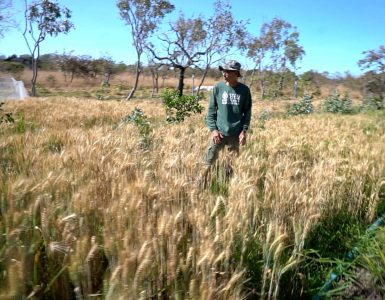Oxen and cows are large animals. Therefore, according to the definitions of the Syntropic Agriculture, they are animals of Abundance Systems. Not by chance, this system is also called by Ernst Götsch of “Outflow Systems.” At this moment, the strategy of the ecosystem is not only the accumulation of natural capital (a task carried out in previous systems), but also to outflow and transport excedent resources. Some signs of that stage are the constant increase of available Phosphorus and the narrowing down of Carbon and Nitrogen ratio, meaning that the ecosystem is now able to support medium and large animals. In Abundance Systems, the presence of these animals is not only possible but also appropriate. In addition to finding the ideal conditions for their development, they also participate in ecosystem management through their metabolism and their migratory behavior.
In the video below Ernst Götsch tells us what oxen and cows should eat in a Mediterranean context: leaves of vines, ash tree and poplar leaves, as well as lucerne (Medicago sativa), subterranean clover (Trifolium subterraneum), Dactylis glomerata, Festuca pratensis, Lolium L, among others.
The landscape described by Götsch derives from his perception that the Mediterranean is an ecosystem designed to “remain green all year round” despite the temperature and humidity variations. However, what we witness today is a reality far distant from that stratified, biodiverse, natural and dynamic forest envisioned by Ernst Götsch. Even though these large ruminants were supposed to live in Abundance Systems, the conditions of most cattle farms today indicates they are in Accumulation Systems – a successional step in which there is no suitable food, habitat, or adequate function for these animals. The result is inefficient pastureland and low productivity, which leads to the need for food supplementation, which means:
- Economic loss: since the operation is more expensive.
- An ecological disadvantage, as it usually means that some ecosystem elsewhere is being mined to supply another with grains and fibers.
- The reduction of animal welfare, as they can't express their natural habits and healthy behavior of foraging.
But then, how to restore an abundant Mediterranean forest? Ernst Götsch’s answer is categorical: “turn your enemy into your ally.”
In that case, the proposal was to use Cistus sp – hated for its capacity to occupy pastures – to help establish holm-oaks, olive-trees, arbutus, fig trees, and vines. The suggestion is specific to the site analyzed, but the logic behind the explanation is the same as always: to make a syntropic evaluation of the ecosystem, which means, design it to potentiate life’s quantity and quality. For us who have been following Ernst Götsch’s work for years, it was like listening to the same old familiar story, but now being told with different characters. Irrespective of existing soil, climate and vegetation conditions, we can, as Ernst says, create agroecosystems similar to natural ones, both in their form and in their dynamics and function. We are also large animals and therefore also depend on Abundance Systems to survive. Our role, as animals that call themselves sapiens sapiens, would be to understand and potentialize the syntropic processes of life.






